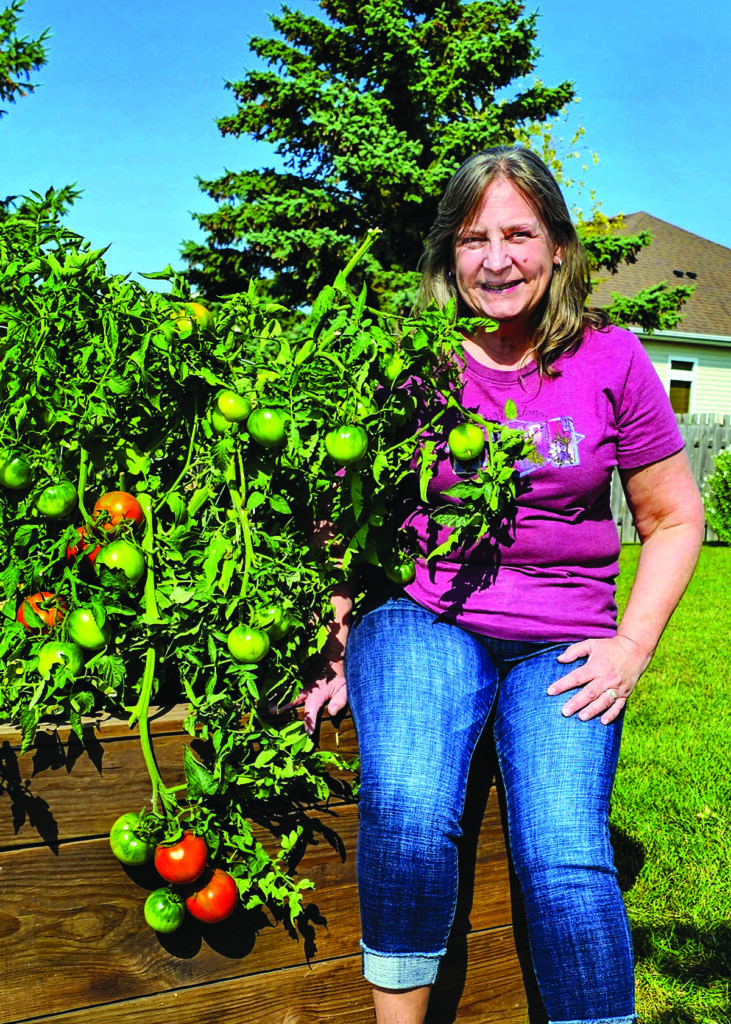
Master gardener Sandy Knutson advises cleaning debris from the garden as vegetables and flowers end their seasons, sparing tomatoes until their fruits ripen. (Photo/Nancy Hanson)
Nancy Edmonds Hanson
The daylight is shrinking. The nights grow chilly. As the leaves turn and autumn takes its turn in the spotlight, gardeners’ feelings are mixed: The harvest is coming in, a big win after a summer of work … but the drudgery of wrapping up the growing season lies straight ahead.
Master gardener Sandy Knutson knows the feeling well. Most of what grew so well in her raised-bed garden on the east side of Moorhead is done and gone, the greens cleared away, the peas and beans picked, the beets dug, and the barren brown vines and stalks that grew them pulled and sent to the city’s compost site. Only dangling still-green and reddening tomatoes remain, along with a hardy row of kale.
“It’s a good idea to clean them out as you’re done harvesting,” the expert grower suggests. “If powdery mildew or other diseases have been a problem, it’s best to be done with them. Don’t put them in your own compost pile at home; it doesn’t get warm enough to wipe them out. Instead, send them to the city. Its much larger compost pile gets hot enough to insure those pathogens get killed.” Leaving the detritus in place until next spring could permit diseases and pests to overwinter in the soil. “Don’t give them the opportunity to create more problems next year,” she advises.
Don’t forget the fruit. After you’ve picked those apples, don’t stop now. What about the gnarled, soft rejects that are bound to be scattered on the ground. “Pick up all that dropped and rotting fruit before the snow comes,” Sandy says. “Leaving it leads to spreading soil diseases.”
Sandy is one of a small group of local growers who are part of the University of Minnesota’s Master Gardener volunteer program. Organized here by the Clay County Extension Service, they have completed the 14-part education course (online or in person) focusing on research-based horticultural knowledge and practices. After graduating, they volunteer their time in a wide range of collaborative projects in their own communities. As the U of M program’s website puts it, they seek to “inspire change to promote healthy people, healthy communities and a healthy planet.”
In their first year as Master Gardeners, the volunteers are expected to donate at least 50 hours of work in those public projects. Each county has its own requirements for continuing education in subsequent years, a total of five classroom hours in Clay County. Extension educator Randy Nelson taught the classes until leaving his post for the University of Minnesota-Crookston this fall.
“I wanted to understand more about the science of gardening – scientifically proven methods,” Sandy says of her decision to step up six years ago. “It’s amazing to me how our world was created with all the pieces operating perfectly together. I wanted to learn more about the best ways to work with it.”
Here in Clay County, the Master Gardeners have been involved in a variety of programs, ranging from the community garden near the Moorhead Scheels store and the US Bank pollinator garden across the street to planters at the Joint Law Enforcement Center and Clay County Courthouse. They collaborate on the summer project called One Vegetable—One Community. Packets of the veggie of the year are shared free at the Moorhead and Hawley libraries, along with guidance in raising them and consuming their bounty. Lettuce was the greenery of the season just past; previous years have spotlighted beans, carrots, zucchini and beets. They have also supported the annual plant exchange at the Heritage Garden in Woodlawn Park.
Sandy’s biggest project has been staffing the Ask a Master Gardener booth at the Clay County Fair. There she helps novice gardeners (and occasionally puzzled veteran grower) solve mysteries and increase their growing successes.
Annual flowers present few choices as they die off at season’s end. Clearly, she says, they should be pulled and composted. Perennials, though, demand more nuanced action.
“There are two ways to approach them. You can clean them up now, or leave them as a winterscape,” she suggests. Besides providing graceful brown fronds to peek out of deep-winter drifts, the latter approach has benefits for the beneficial insects who seek shelter in them. “Winterscaping provides habitat,” she says. “That’s why I leave mine – especially coneflowers, rudbeckia and liatris, as well as ornamental grasses.” As a bonus, last year’s dead and dried greenery often provides seeds for birds, as well as potential havens from the storm.
However, Sandy makes an exception for perennials like hostas that turn soggy as winter sets in. “I cut them down,” she admits. “They’re disgusting.”
Fall clean-up shouldn’t end when the garden has been denuded, Sandy cautions. “When you’re done, clean your garden tools,” she advises. “If soil or debris is stuck to them, use soapy water and a steel brush.” She adds, “If you’ve used them on diseased plants, I’d go further.” She suggests sanitizing them with a solution of one part bleach to 10 parts water, then drying thoroughly.
She encourages her fellow gardeners to take the next step, as she did, and enroll in next year’s Master Gardener volunteer program. The deadline for submitting applications is Oct. 1, with the core course beginning in January. For more information, go to www.extension.umn.edu/volunteer#master-gardener.


